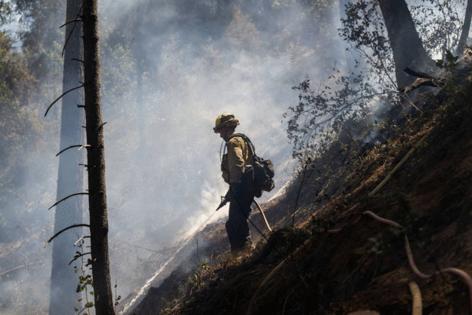California firefighters will soon have a 66-hour work week. Why Cal Fire will make the change
Published in News & Features
SACRAMENTO, Calif. — When Tim Edwards started working as a full-time firefighter for the state in 1994, his schedule was grueling.
For 96 hours straight, California firefighters would respond to calls at all hours of the night — and that was when they weren’t working weeks at a time to respond to a wildfire. Seasonal firefighters were only compensated 19 hours a day, despite being on call 24/7.
Now, three decades later, state firefighters could be on the clock 30 fewer hours if unionized workers agree to a contract securing a 66-hour workweek next month.
The reduction in hours marks an improvement in work-life balance for employees of the California Department of Forestry and Fire Protection, who currently have schedules that average 72 hours a week, when they’re not fighting intense fires that demand around-the-clock attention.
The long-awaited schedule change comes as California grapples with increasingly severe and frequent wildfires — and a renewed interest in protecting the health of the workforce tasked with protecting the state’s population, property and natural resources.
As the president of Cal Fire Local 2881, Edwards is not stopping at 66 hours. After two years under the new contract, the union, which represents state-employed firefighters, fire captains and fire apparatus engineers expects the state to adopt a 56-hour workweek — the fire service industry standard.
“The push for a 56 [hour schedule] not only is good for the mental, physical health of our members and their families, but to the recruitment and retention of paid professional firefighters in the state of California,” Edwards said. “Which ultimately adds the protection and safety of the residents of California.”
Currently members of the union are considering a contract that would finalize the 66-hour workweek. If Cal Fire employees approve the proposed agreement next month, the state will begin the years-long process of hiring thousands more firefighters to bolster Cal Fire’s workforce and create enough crews to handle the schedule shift.
The significant recruitment efforts to staff new positions could take months to complete, Cal Fire said. The department is actively recruiting at job fairs throughout the state; advertising on state vehicles and billboards; and attracting prospective employees on a number of different online platforms, including the state’s CalCareers site.
“New workforce and the need for increased capacity in our training programs to ensure readiness to work is also something we continue to heavily focus on as we embrace the challenge of an overall cultural shift which will align CAL FIRE with the fire service industry standard workweek,” Cal Fire Battalion Chief Jesse Torres said.
After the union initiated the process to move away from the 72-hour schedule two years ago, a budget shortfall threatened to derail the schedule shift. The Legislative Analyst’s Office estimated the proposal would result in a 20% increase in the department’s budget and staffing levels. Given the high cost of the proposal and a “lack of clarity regarding future economic conditions,” the LAO recommended delaying transition.
Gov. Gavin Newsom negotiated an 8% cut to General Fund state operations — achieved through the elimination of excess positions among other means — earlier this year to address the significant shortfall, but firefighters’ schedule change emerged from the budget fight intact.
The steadfast support of Cal Fire employees comes in response to a greater awareness of the physical and mental health strains firefighters face when battling wildfires made worse by the effects of climate change. This year’s fire season has proven more destructive than in recent years, with the Park Fire burning nearly 430,000 acres to become the state’s fourth-largest fire on record.
On top of those pressures, Edwards said, the number of inmate firefighting crews has decreased in recent years due to prison reforms. Additionally, Cal Fire continues to lose employees to city and county fire departments that offer more sustainable schedules.
“It’s sad that we lose highly trained individuals because of our working conditions and our wages,” Edwards said. “This contract puts us one step closer to retaining and recruiting highly trained professional firefighters.”
An additional day off
The current schedule has firefighters working 72 hours per week, three days on, four days off. With the exception of overtime, firefighters work 12 days each pay period.
Under the new schedules, firefighters will work 11 days each pay period on average.
The ability to decompress from the stress of working in the fire service will be a major improvement in the lives of firefighters, said Kevin Anderson, a Cal Fire captain at the San Luis Obispo Airport station.
“They all want to be able to spend time with their kids and be able to go to sporting events and things like that,” said Anderson, who also serves as the San Luis Obispo chapter director with Local 2881. With the additional day off, he said, “they’ll be able to actually do that.”
In reality, firefighters’ schedules won’t change immediately. Cal Fire said it will take time to hire enough people to fill in the gaps.
This year’s budget includes nearly $200 million to hire 338 additional positions to help shift over to the 66-hour workweek. But state analysts estimate nearly 2,500 permanent positions will be necessary to fully make the switch by fiscal year 2028‑29, with the ongoing annual cost was estimated to be roughly $770 million.
When the schedule goes into effect in November, Edwards said, “98% of the state will still technically be working 72 hours until we get more people hired.”
In the last decade, Cal Fire has nearly doubled in size. Between 2014 and 2024, the number of Cal Fire positions devoted to fire protection grew from over 5,700 to nearly 10,300, the LAO reported. During the last decade, the combined budget for fire prevention and protection also doubled, growing from $1.7 billion to $3.7 billion.
Torres, with Cal Fire, said he could not predict the number of positions the department expected to fill by the end of the year.
Like Cal Fire, the United States Forest Service has struggle to fill its ranks at times to meet demand. Dangerous working conditions and low pay have forced more federal wildland firefighters to seek other employment.
“We see a lot of our new employees come from our federal partners, United States Forest Service,” Torres said. “They leave that agency and come over to Cal Fire in the same way that we’ve lost a lot of our employees to local government who have higher salary rates.”
Training wheels
Omar Ali, a station captain with Cal Fire and district vice president with Local 2881 out of San Diego, said Cal Fire has been considered a stepping stone in firefighters’ careers. Cal Fire employees often left to take jobs with bigger municipal fire departments, Ali said, “and their biggest complaint was the workweek.”
Most municipal fire departments work a 56-hour schedule, he said. Adopting a 66-hour workweek, he explained, should incentivize firefighters to stay on with the state.
Ali said the current contract before members is really just the “training wheels” until the state can adopt the industry standard of a 56-hour workweek.
“This is something that I never thought I’d see in my career,” Ali said, who has been with Cal Fire since 2000. “It’s going to be huge for the department for retaining our new hires and the longevity of our employees.”
Edwards said that while changing from 72 to 66 hours will require the state to hire “relief personnel” to fill the gaps, once those additional firefighters are employed, switching to a 56-hour workweek should be a feasible goal for the state.
“We are the largest fire department in North America, we are the most diverse fire department, and we offer the most protection and safety for the residents of California,” Edwards said. “And it’s sad that we lose highly trained individuals because of our working conditions and our wages.”
____
©2024 The Sacramento Bee. Visit at sacbee.com. Distributed by Tribune Content Agency, LLC.







Comments